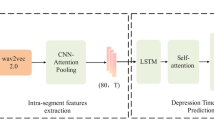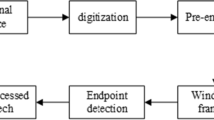Abstract
This paper introduces a novel approach for depression classification, utilizing multimodal token merging (ToMe) within a speech spectrotemporal transformer framework. The model’s efficacy is evaluated with log-mel spectrograms and autocorrelation tempograms extracted from depressed and non depressed speech. The results demonstrate the effectiveness of ToMe when integrated with attention mechanisms of audio spectrogram transformer (AST) models, such as AST and data efficient image transformer (DeiT) encoders. This underscores the importance of the token pruning mechanism utilized in the study. Additionally, a multimodal dual-channel architecture is introduced, featuring two distinct feature modalities extracted from speech: spectrograms and autocorrelation tempograms. The novel ToMe dual-channel AST and ToMe dual-channel AST with DeiT encoder models demonstrate remarkable performance on two different datasets, namely the EATD-Corpus (Chinese) and DAIC-WoZ (English), providing promising results for depression detection.
Access this chapter
Tax calculation will be finalised at checkout
Purchases are for personal use only
Similar content being viewed by others
References
Al Hanai, T., Ghassemi, M.M., Glass, J.R.: Detecting depression with audio/text sequence modeling of interviews. In: Interspeech, pp. 1716–1720 (2018)
Alhanai, T., Ghassemi, M., Glass, J.: Detecting depression with audio/text sequence modeling of interviews. In: Proceedings of the Annual Conference of the International Speech Communication Association, INTERSPEECH 2018-September, pp. 1716–1720 (2018). https://doi.org/10.21437/Interspeech.2018-2522
Association, A.P., et al.: Diagnostic and statistical manual of mental disorders. Text revision (2000)
Bolya, D., Fu, C.Y., Dai, X., Zhang, P., Feichtenhofer, C., Hoffman, J.: Token merging: your vit but faster (2023)
Cummins, N., Scherer, S., Krajewski, J., Schnieder, S., Epps, J., Quatieri, T.F.: A review of depression and suicide risk assessment using speech analysis. Speech Commun. 71, 10–49 (2015)
Dablain, D., Krawczyk, B., Chawla, N.V.: Deepsmote: fusing deep learning and smote for imbalanced data. IEEE Trans. Neural Netw. Learn. Syst. 34(9), 6390–6404 (2022)
Dosovitskiy, A., et al.: An image is worth 16\(\times \)16 words: transformers for image recognition at scale (2021)
Elkin, I., et al.: National institute of mental health treatment of depression collaborative research program: general effectiveness of treatments. Arch. General Psychiat. 46(11), 971–982 (1989). https://doi.org/10.1001/archpsyc.1989.01810110013002
France, D.J., Shiavi, R.G., Silverman, S., Silverman, M., Wilkes, M.: Acoustical properties of speech as indicators of depression and suicidal risk. IEEE Trans. Biomed. Eng. 47(7), 829–837 (2000)
Fraser, G., Boashash, B.: Multiple window spectrogram and time-frequency distributions. In: Proceedings of ICASSP 1994. IEEE International Conference on Acoustics, Speech and Signal Processing. vol. iv, pp. IV/293–IV/296 (1994). https://doi.org/10.1109/ICASSP.1994.389818
Fried, E.I., Nesse, R.M.: Depression sum-scores don’t add up: why analyzing specific depression symptoms is essential. BMC Med. 13(1), 1–11 (2015)
Gong, Y., Chung, Y.A., Glass, J.: Ast: audio spectrogram transformer (2021)
Gratch, J., et al.: The distress analysis interview corpus of human and computer interviews. In: Calzolari, N. (eds.) Proceedings of the Ninth International Conference on Language Resources and Evaluation (LREC’14), pp. 3123–3128. European Language Resources Association (ELRA), Reykjavik (2014). http://www.lrec-conf.org/proceedings/lrec2014/pdf/508Paper.pdf
Grosche, P., Müller, M., Kurth, F.: Cyclic tempogram-a mid-level tempo representation for musicsignals (2010). https://doi.org/10.1109/ICASSP.2010.5495219
Hanai, T., Ghassemi, M., Glass, J.: Detecting depression with audio/text sequence modeling of interviews, pp. 1716–1720 (2018). https://doi.org/10.21437/Interspeech.2018-2522
Iyortsuun, N.K., Kim, S.H., Yang, H.J., Kim, S.W., Jhon, M.: Additive cross-modal attention network (acma) for depression detection based on audio and textual features. IEEE Access 12, 20479–20489 (2024). https://doi.org/10.1109/ACCESS.2024.3362233
Jiang, H., et al.: Detecting depression using an ensemble logistic regression model based on multiple speech features. Comput. Math. Methods Med. 2018 (2018)
Kaustubh, K., Gogoi, P., Prasanna, S.: Rhythm formant analysis for automatic depression classification. In: International Conference on Speech and Computer, pp. 94–106. Springer, Heidelberg (2023). https://doi.org/10.1007/978-3-031-48309-7_8
Lam, G., Huang, D., Lin, W.: Context-aware deep learning for multi-modal depression detection. In: ICASSP 2019 - 2019 IEEE International Conference on Acoustics, Speech and Signal Processing (ICASSP), pp. 3946–3950 (2019). https://api.semanticscholar.org/CorpusID:145833193
Lu, J., Liu, B., Lian, Z., Cai, C., Tao, J., Zhao, Z.: Prediction of depression severity based on transformer encoder and cnn model. In: 2022 13th International Symposium on Chinese Spoken Language Processing (ISCSLP), pp. 339–343. IEEE (2022)
Ma, X., Yang, H., Chen, Q., Huang, D., Wang, Y.: Depaudionet: an efficient deep model for audio based depression classification. In: Proceedings of the 6th International Workshop on Audio/Visual Emotion Challenge, pp. 35–42 (2016)
Ma, X., Yang, H., Chen, Q., Huang, D., Wang, Y.: Depaudionet: an efficient deep model for audio based depression classification. In: Proceedings of the 6th International Workshop on Audio/Visual Emotion Challenge (2016). https://api.semanticscholar.org/CorpusID:2518379
McFee, B., et al.: librosa: audio and music signal analysis in python. In: Proceedings of the 14th Python in Science Conference, vol. 8 (2015)
Othmani, A., Kadoch, D., Bentounes, K., Rejaibi, E., Alfred, R., Hadid, A.: Towards robust deep neural networks for affect and depression recognition from speech. In: Del Bimbo, A., et al. (eds.) ICPR 2021. LNCS, vol. 12662, pp. 5–19. Springer, Cham (2021). https://doi.org/10.1007/978-3-030-68790-8_1
Park, D.S., et al.: Specaugment: a simple data augmentation method for automatic speech recognition. arXiv preprint arXiv:1904.08779 (2019)
Paszke, A., et al.: Pytorch: an imperative style, high-performance deep learning library (2019). https://arxiv.org/abs/1912.01703
Sardari, S., Nakisa, B., Rastgoo, M.N., Eklund, P.: Audio based depression detection using convolutional autoencoder. Expert Syst. Appl. 189, 116076 (2022)
Satt, A., Rozenberg, S., Hoory, R., et al.: Efficient emotion recognition from speech using deep learning on spectrograms. In: Interspeech, pp. 1089–1093 (2017)
Shen, Y., Yang, H., Lin, L.: Automatic depression detection: an emotional audio-textual corpus and a gru/bilstm-based model (2022)
Touvron, H., Cord, M., Douze, M., Massa, F., Sablayrolles, A., Jégou, H.: Training data-efficient image transformers & distillation through attention (2021)
Valstar, M., et al.: Avec 2016 - depression, mood, and emotion recognition workshop and challenge (2016)
Verde, L., et al.: A lightweight machine learning approach to detect depression from speech analysis. In: 2021 IEEE 33rd International Conference on Tools with Artificial Intelligence (ICTAI), pp. 330–335. IEEE (2021)
Wei, P.C., Peng, K., Roitberg, A., Yang, K., Zhang, J., Stiefelhagen, R.: Multi-modal depression estimation based on sub-attentional fusion (2022)
Wu, P., Wang, R., Lin, H., Zhang, F., Tu, J., Sun, M.: Automatic depression recognition by intelligent speech signal processing: a systematic survey. CAAI Trans. Intell. Technol. 8(3), 701–711 (2023)
Zhao, Z., et al.: Automatic assessment of depression from speech via a hierarchical attention transfer network and attention autoencoders. IEEE J. Sel. Topics Signal Process. 14(2), 423–434 (2019)
Author information
Authors and Affiliations
Corresponding author
Editor information
Editors and Affiliations
Rights and permissions
Copyright information
© 2025 The Author(s), under exclusive license to Springer Nature Switzerland AG
About this paper
Cite this paper
Kumar, L., Kaustubh, K., Prasanna, S.R.M. (2025). Depression Classification Using Token Merging-Based Speech Spectrotemporal Transformer. In: Karpov, A., Delić, V. (eds) Speech and Computer. SPECOM 2024. Lecture Notes in Computer Science(), vol 15299. Springer, Cham. https://doi.org/10.1007/978-3-031-77961-9_24
Download citation
DOI: https://doi.org/10.1007/978-3-031-77961-9_24
Published:
Publisher Name: Springer, Cham
Print ISBN: 978-3-031-77960-2
Online ISBN: 978-3-031-77961-9
eBook Packages: Computer ScienceComputer Science (R0)




